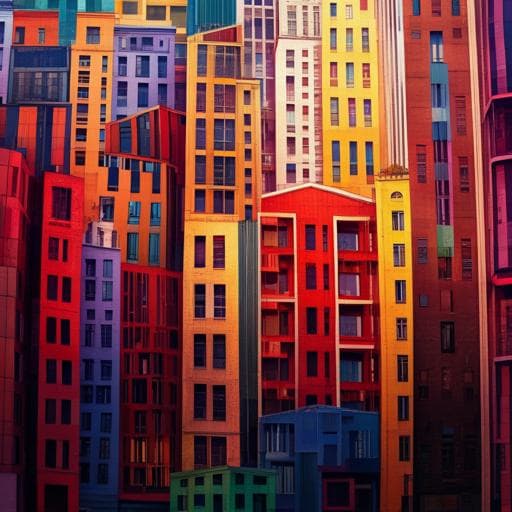
Social Work
What are the differences in urban citizens' preferences for the colour of condominium building facades?
K. Chen, H. Lin, et al.
This research conducted by Kaida Chen, Hanliang Lin, Oliver F. Shyr, and Shuying You delves into urban consumers' preferences for condominium building facade colors in Fuzhou, China. By analyzing second-hand residential transaction data from 2020, the study uncovers the distinct color preferences influenced by various income levels and geographic locations, offering valuable insights for social psychology and urban planning.
~3 min • Beginner • English
Introduction
The study investigates how urban condominium buyers’ preferences for facade colours manifest in transaction prices and what these preferences reveal about consumer psychology. Prior work shows colours shape emotions and purchase behavior and can influence price for various goods, yet housing facade colour effects on actual market behavior remain underexplored. Existing colour-preference research often uses lab experiments or surveys and seldom integrates revealed-preference pricing data or examines heterogeneity by purchasing power or geography. This study addresses these gaps by using housing prices to infer group-level colour preferences, focusing on Fuzhou, China, to examine: (1) common preferences for facade colour quantity and features; (2) differences across consumer groups segmented by purchasing power (income/price quantiles); and (3) spatial differences across urban regions. The research is important for understanding social psychology in urban consumption, informing urban design and planning, and offering a transferable methodology.
Literature Review
The paper reviews evidence that colour affects emotions and consumer choice, with societal and cultural influences shaping group preferences and individual variability. Prior studies on products show colour impacts perceived utility, quality, and price premiums (e.g., vehicles and apparel), and that when quality is comparable, exterior colour can be decisive. Architectural research indicates preferences for certain facade colours and characteristics across contexts (Japan, China, Iran), including associations between satisfaction and facade colour harmony, and general preferences for brighter, lower-chroma palettes in some Chinese cities. Methodologically, prior work primarily used experiments and surveys to assess colour preferences (e.g., Tosca 1994; Cubukcu & Kahraman 2008; Li et al. 2020; Gou et al. 2021), with some regression-based analyses focusing on colour distributions but not integrating user price feedback. Table 2 summarises key themes: preference for polychromy (peaking at tri-/tetrachromy), mixed findings on preferred lightness and saturation, associations of residences with red and blue hues, and preferences for certain contrasts (e.g., greater lightness difference between primary and supplementary colours). The authors identify a gap in using hedonic price models to infer real-market colour preferences and in examining heterogeneity by purchasing power and geography.
Methodology
Study area and data: Fuzhou, China (longitude 119.28E, latitude 26.08N), an East Asian coastal city with active housing markets and cultural linkages. Cross-sectional data comprise 906 second-hand residential community samples in 2020 across five urban administrative regions (Gulou, Cangshan, Taijiang, Jin’an, Minhou). Outcome variable: average transaction price (ten-thousand yuan/m²) per community. Control variables (guided by prior studies) cover: location environment (higher-level administrative status; within 2nd/3rd ring; population; per-capita GDP), self-characteristics (pure commercial community; developer top-500; developer local; adjacency to high-quality primary/middle school; built after 2000; building density; greening rate; monthly management fee), and facility accessibility (distances to nearest rail station, market, grade-A tertiary hospital, scenic spot, green space, main water source, funeral facility, factory, gas station, dump). Sample selection criteria: (1) full-type non-villa communities to reduce type-induced price variation; (2) consistent exterior architectural style across buildings within each community; (3) second-hand properties only; (4) facades measurable by colour assessment instruments; (5) at least five complete 2020 transactions per community.
Colour variables: Two groups—(A) colour quantity (1, 2, 3, or ≥4 facade colours) and (B) colour features. Using computerised street image recognition, facade colours were segmented by tolerance and ranked by area share: primary colour (1–100%), secondary (0–49%), primary decorative (0–33%), secondary decorative (0–24%). For each component, field measurements via colourimeter recorded CMY density values and converted to LAB and LCH standards. For missing components (if fewer colours present), features default to the lowest-proportion existing colour’s features. Primary colour features include lightness (L), red–green (A in LAB), yellow–blue (B in LAB), saturation (C in LCH), and hue (H in LCH). Difference features are absolute differences between primary and: secondary, primary decorative, and secondary decorative colours across lightness, red–green, yellow–blue, and saturation/hue metrics.
Models: (1) Hedonic price model: ln(price) regressed on controls and colour variables via OLS: lnP = α + Σβ lnX + ε. Diagnostics include R², VIF, Durbin–Watson, robustness checks (alternative colour standards LAB/LCH). (2) Quantile regression (Koenker–Bassett) at τ = 0.05, 0.25, 0.50, 0.75, 0.95 to capture heterogeneity across price segments, interpreted as groups with differing purchasing power; report pseudo-R² and MAE. (3) Spatial analysis: Moran’s I for spatial autocorrelation, then Geographically Weighted Regression (GWR) to estimate spatially varying relationships: yᵢ = β₀(uᵢ,vᵢ)+Σβₖ(uᵢ,vᵢ)xᵢₖ+εᵢ; report fit (−2 log-likelihood, CV, R², Adj-R²) and coefficient ranges (min–max) to characterise spatial heterogeneity.
Research framework: Part I constructs colour variables (quantity and features). Part II links them to prices via linear (all consumers), quantile (different purchasing power), and spatial (regional heterogeneity) regressions.
Key Findings
Linear regression: Models fit well (Adj-R² ≈ 0.706–0.715; VIF<10; DW≈1.86–1.88) with robust results across LAB/LCH specifications. Control variables mostly align with expectations: positive effects for central locations, higher-level administrative regions, population, GDP, commercial status, reputable developers, proximity to quality schools, newer builds, greening, and management fee; negative effects for greater distances to rail, markets, hospitals, green space, and water; positive for distances to scenic spots, factories, gas stations, dumps, and funeral facilities. Key colour results: more facade colours are associated with higher prices—relative to one colour, coefficients for 2C, 3C, 4C are positive and significant (e.g., LAB: 2C≈0.055, 3C≈0.070, 4C≈0.127; LCH: 2C≈0.047, 3C≈0.060, 4C≈0.082). Across groups, buyers prefer primary colours with red and blue tendencies; no consistent group-level preference for primary lightness/saturation. In primary–secondary contrasts, buyers prefer low lightness difference and high saturation difference; they favour red–green difference but not yellow–blue difference.
Quantile regression: Pseudo-R² ≈ 0.46–0.54. Lower-price segments (lower purchasing power) show stronger positive valuation for additional colours; higher segments show weaker or even negative valuation for ≥4 colours. Preference heterogeneity in primary colour features: low/middle segments prefer brighter, lower-saturation primary reds; high segment prefers darker, higher-saturation primary yellows. For primary–secondary contrasts, low/middle segments prefer small lightness differences and large saturation and red–green differences, with aversion to yellow–blue differences; high segment prefers larger lightness differences but shows little preference for colour-tendency or saturation differences. Differences with decorative colours: low segment favours small differences (coordination) with primary; middle shows preference for large yellow–blue and saturation differences for primary decorative colour; high segment favours larger differences (contrast) for primary decorative colour but prefers smaller differences with secondary decorative colour.
Spatial regression: GWR shows strong fit (R²≈0.807; Adj-R²≈0.801; CV≈0.020), with substantial spatial variability in coefficients. Sensitivity to colour quantity is geographically concentrated—preferences for 2–3 colours cluster similarly; preference for ≥4 colours is stronger in eastern Fuzhou along the Minjiang River. Preferences for primary red–green tendency cluster around active commercial hubs (e.g., Wanda Plaza, Shiou Plaza), indicating stronger red preference; aversion to red appears near Three Lanes and Seven Alleys (historic, affluent area favouring simple aesthetics). Yellow tendency is preferred in urban periphery; downtown Taijiang/Cangshan tend to dislike yellow; blue-tendency areas align with high-amenity, high-price zones with river views and greenery. For primary–secondary contrasts, strongest preferences for high lightness contrast near Shangxiahang (Taijiang); red–green contrast preference is widespread (strongest north of the old city); yellow–blue and saturation difference sensitivities show mixed spatial patterns, often suburban. Overall, the most favoured configuration across the city is often: ≥4 colours; dark red primary and dark green secondary; small lightness difference; strong saturation contrast.
Discussion
Findings indicate that market prices embed revealed preferences for facade colour attributes. The positive price premium for greater colour quantity likely reflects both cost implications (more materials/design complexity) and consumer preference for visually richer facades. Emotionally, red and blue primary tendencies align with cross-cultural associations (warmth/festivity; calm/serenity). Preferences in contrasts suggest consumers value coordinated brightness but stimulating saturation differences and red–green balance, rather than yellow–blue differences. Heterogeneity is pronounced: lower purchasing-power groups strongly prefer polychromy and bright, low-saturation reds with clear contrasts, reflecting conventional and expressive preferences; higher purchasing-power groups often value restraint in colour quantity and prefer darker, high-saturation yellows with stronger lightness contrasts, reflecting understated luxury in an East Asian context. Spatially, commercial areas correlate with red preference (youthful/active), while historic affluent districts resist red, preferring simplicity; peripheral areas’ preference for yellow aligns with aspirational wealth symbolism, whereas central high-amenity areas tilt toward blue-associated calm. These differentiated preferences suggest aesthetic psychology varies systematically with purchasing power and urban context, informing targeted design and planning.
Conclusion
This study introduces an interdisciplinary approach combining field colour measurement, computer vision, and econometric and spatial models to infer urban consumers’ facade colour preferences from housing prices. In Fuzhou, common preferences include: premiums for facades with more colours (often ≥4); primary red/blue tendencies; low primary–secondary lightness difference; high saturation contrast; preference for red–green differences over yellow–blue. A widely favoured configuration is a facade with four or more colours, dark red as primary, dark green as secondary, similar lightness, and strong saturation contrast. Preferences diverge by purchasing power: low/middle groups lean conservative and vivid (bright, low-saturation reds; coordinated lightness; strong saturation/red–green contrasts), while high-consumption groups favour darker, high-saturation yellows and stronger lightness contrasts with simpler overall palettes. Spatial heterogeneity maps onto commercial vs cultural districts and urban core vs periphery. Methodologically, the study offers a transferable framework to other culturally similar regions. Future work could extend to broader cultural contexts and integrate additional facade attributes to generalise and refine these insights.
Limitations
The analysis isolates colour quantity and features but does not explicitly model other correlated facade attributes (e.g., materials, textures). Colour information is complex; aspects such as precise spatial placement and shapes of coloured elements are not quantified. Psychological interpretations of preference variability are inferred from prior literature and experience and may not be universally applicable. Cultural specificity may limit generalisability beyond East Asian contexts and cities with similar cultural backgrounds. Cross-sectional data from 2020 second-hand communities may not capture temporal dynamics or new-build markets.
Related Publications
Explore these studies to deepen your understanding of the subject.







